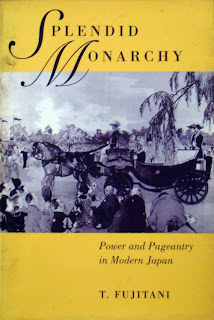 Splendid Monarchy
Splendid MonarchyPower & Pageantry in Modern Japan
T. Fujitani
University of California Press
ISBN 0-520-21371-8
305 pp
The Meiji Restoration of 1868 is inaccurately named. There was no restoration of a previously existing imperial system, but a complete reinvention and manufacture of a new imperial system. At that time the vast majority of Japanese had no idea who, or what, the emperor was.
Faced with creating a modern Nation-State out of a diverse collection of horizonatally seperated domains and provinces, and rigidly separated vertical classes, the new leaders of Japan chose to build an imperial system to serve as the unifying paradigm.
As with so much of the new Japan, they looked to the West for models, and in the case of the imperial system, to European monarchies, especially Britain's.
Fujitani focuses mainly on the external public forms, the new state ceremonies and great public buildings, but there is a lot of fascinating background on the creation of the new religion of State Shinto,- the destruction of local nature-based shrines, the suppression of "superstitions", the creation of national shinto ceremonies, Yasakuni, the enshrinement of emperors, and so on, as well as the rewriting of history to make the imperial system central to Japanese history.
All Nation-States have used "invented traditions" in their creation, but what comes across in Japan's case is not only the extent and number of these invented traditions, but the fact that they are so widely believed, by Japanese and foreigner alike, to extend back into Japan's past.
Perhaps the clearest example of this is the "traditional" Shinto wedding. I personally have asked more than one hundred Japanese of all ages when this "ancient" ceremony began, and so far I have not been given a single correct answer. The very first Shinto wedding was held in 1905, scarcely 100 years ago, and it was modelled largely on the Christian Royal Weddings of the British monarchy.
A fascinating book for those who wish to learn more about just exactly how modern Japan is, and the massive disjunction between modern Japan and its past.
Another great book review.
ReplyDeleteThanks Ojisanjake!